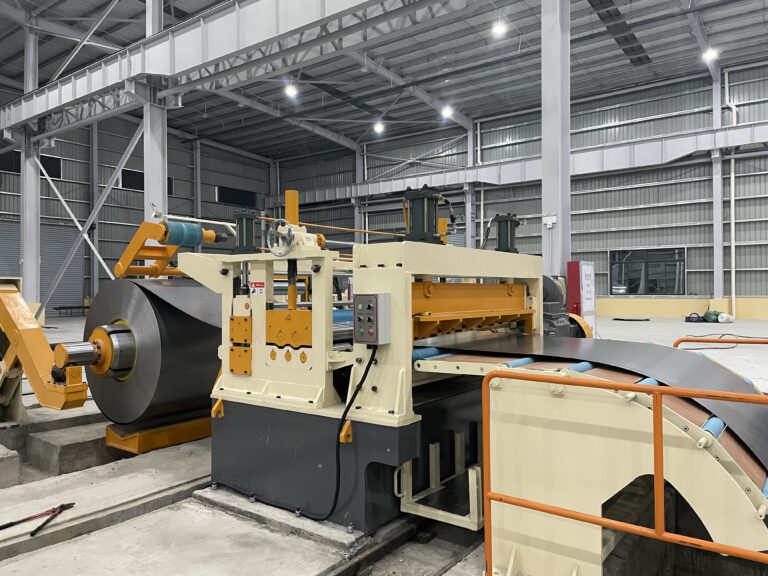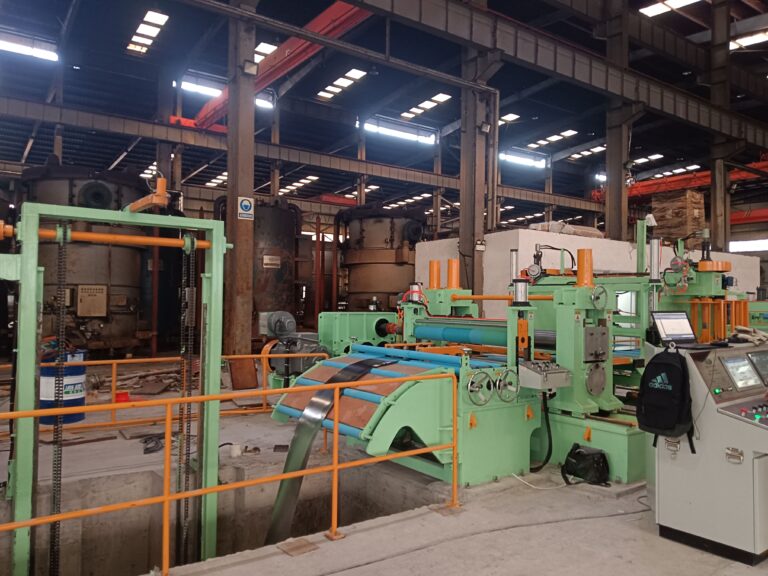5 Key Advantages of Cut-to-Length Lines for Sheet-Metal Fabricators
Sheet-metal fabricators face mounting pressure to improve efficiency, reduce waste, and maintain consistent quality while meeting increasingly tight delivery schedules.
Sheet-metal fabricators face mounting pressure to improve efficiency, reduce waste, and maintain consistent quality while meeting increasingly tight delivery schedules. Cut-to-length (CTL) lines address these critical challenges through automated precision cutting, material waste reduction, enhanced production throughput, improved quality consistency, and operational flexibility. These systems transform large metal coils into precise sheet dimensions through integrated uncoiling, leveling, measuring, cutting, and stacking operations, eliminating the dimensional variations and material waste inherent in manual cutting processes.
Understanding these five key advantages enables fabricators to make informed decisions about production automation investments, evaluate ROI potential, and identify the most suitable CTL solutions for their specific manufacturing requirements.
Understanding the Sheet-Metal Fabricator’s Challenge
Current Industry Pain Points
Modern sheet-metal fabricators operate in an increasingly competitive environment where margins are under constant pressure. Traditional manual cutting processes create several critical challenges:
Dimensional Inconsistency: Manual cutting typically achieves tolerances of ±2-3mm, insufficient for precision applications requiring tight dimensional control.
Material Waste: Manual operations often result in 5-8% material waste due to measurement errors, cutting variations, and inefficient coil utilization.
Labor Intensity: Traditional cutting requires 3-4 skilled operators per line, creating high labor costs and dependency on operator skill levels.
Production Bottlenecks: Manual processing speeds of 10-15 equivalent meters per minute limit overall production capacity and customer responsiveness.
Quality Variations: Inconsistent edge quality, surface damage, and dimensional variations lead to downstream processing problems and customer complaints.
Advantage 1: Precision Cutting That Eliminates Costly Rework
The Accuracy Challenge in Modern Manufacturing
Sheet-metal fabricators serving automotive, aerospace, and precision equipment industries require dimensional accuracy that manual cutting cannot consistently deliver. Applications such as automotive body panels, electronic enclosures, and HVAC components demand tolerances within ±0.5mm or tighter.
How CTL Systems Achieve Superior Precision
Cut-to-length lines utilize servo-controlled measuring systems, laser positioning technology, and programmable shear timing to achieve consistent cutting accuracy:
Servo-Controlled Measuring: Precision measuring wheels with encoder feedback provide accurate length measurement independent of material thickness or surface variations.
Programmable Cutting Sequences: Computer-controlled systems eliminate human measurement errors and ensure repeatable cutting patterns.
Mechanical Stability: Heavy-duty machine frames and precision guide systems maintain dimensional accuracy across varying material thicknesses and widths.
Measurable Precision Benefits
Industry studies indicate that automated CTL systems typically achieve:
- Cutting tolerances of ±0.2mm to ±0.5mm depending on material thickness
- 95% reduction in dimensional rework compared to manual cutting
- Consistent accuracy across production runs regardless of operator skill level
- Elimination of cumulative measurement errors in batch processing
Real-World Application: Precision electronic enclosure manufacturers report that CTL automation has eliminated their secondary machining operations, reducing production time by 30% while improving final part accuracy.
Advantage 2: Material Waste Reduction Through Optimized Processing
The Hidden Cost of Material Waste
Material costs typically represent 60-70% of total production costs in sheet-metal fabrication. Even small improvements in material utilization create significant financial impact across annual production volumes.
Systematic Waste Elimination Strategies
Modern CTL lines incorporate multiple waste reduction technologies:
Optimized Cutting Patterns: Computer-controlled systems calculate optimal cutting sequences to minimize end-of-coil waste and maximize material utilization.
Precision Measuring Systems: Accurate length control eliminates the safety margins typically added in manual operations.
Remnant Management: Automated systems track remaining coil lengths and optimize cutting sequences to utilize short lengths effectively.
Edge Trimming Recovery: Side trimming waste is collected separately and can be recycled or sold as scrap at higher value.
Quantifying Waste Reduction Impact
Typical material utilization improvements include:
- Manual cutting: 92-95% material utilization
- Automated CTL systems: 97-98% material utilization
- Improved scrap sorting and recovery value
- Reduced raw material inventory requirements through better planning
The 2-3% utilization improvement translates to substantial cost savings. For a fabricator processing 1,000 tons annually of $1,200/ton material, the improvement represents $24,000-$36,000 in annual material savings alone.
Advantage 3: Production Speed Increases That Transform Capacity
Breaking Through Manual Processing Limitations
Manual cutting operations create inherent speed limitations due to human physical constraints and the sequential nature of measuring, marking, and cutting operations.
CTL Speed Capabilities
Modern cut-to-length lines process material at significantly higher speeds:
- Manual equivalent speed: 10-15 meters/minute
- Semi-automated systems: 50-100 meters/minute
- Advanced CTL lines: 150-300 meters/minute depending on material and thickness
Speed Factors and Optimization
Processing speed varies based on several controllable factors:
Material Thickness: Thinner materials (0.5-2mm) allow maximum processing speeds, while thicker materials (6-12mm) require slower speeds for cut quality.
Cut Length: Shorter pieces allow higher throughput rates, while longer sheets may require speed reduction for handling.
Material Grade: Harder materials like stainless steel require slower processing than standard carbon steel.
Quality Requirements: Applications requiring exceptional edge quality may necessitate reduced processing speeds.
Capacity Transformation Examples
A mid-sized fabrication shop upgrading from manual cutting can expect:
- Daily throughput increase of 200-300%
- Reduced floor space requirements (1 CTL line replaces 8-12 manual stations)
- Improved customer response time through faster processing
- Capacity for additional product lines without facility expansion
Advantage 4: Quality Consistency and Control
The Quality Challenge in Competitive Markets
Inconsistent quality creates customer complaints, warranty costs, and lost business opportunities. Manual processes introduce quality variations that are difficult to control and predict.
Automated Quality Control Features
Modern CTL systems incorporate multiple quality assurance mechanisms:
Consistent Cutting Parameters: Computer-controlled systems maintain optimal cutting speed, blade pressure, and shear angle for each material type.
Real-Time Monitoring: Sensors monitor cutting force, material position, and system performance to detect quality issues immediately.
Integrated Inspection: Some systems include thickness measurement, edge quality monitoring, and surface inspection capabilities.
Statistical Process Control: Data collection capabilities enable trend analysis and predictive quality management.
Quality Improvement Results
Fabricators typically achieve:
- 90% reduction in quality-related customer complaints
- Consistent edge quality meeting or exceeding manual cutting standards
- Reduced inspection requirements due to process consistency
- Improved downstream processing efficiency due to consistent part dimensions
Advantage 5: Operational Flexibility for Diverse Applications
Meeting Varied Customer Requirements
Modern fabricators serve diverse markets requiring different materials, thicknesses, and specifications. Traditional dedicated cutting systems lack the flexibility to handle this variety efficiently.
CTL Flexibility Capabilities
Cut-to-length lines offer several flexibility advantages:
Multi-Material Processing: Single systems can process carbon steel, stainless steel, aluminum, and specialty alloys without dedicated equipment.
Thickness Range: Systems handle wide thickness ranges (typically 0.3-12mm) within the same equipment.
Width Flexibility: Adjustable guides accommodate varying coil widths from narrow strips to wide sheets.
Quick Changeovers: Modern systems achieve material changeovers in 5-15 minutes compared to 30-60 minutes for manual setup.
Flexibility Benefits
Market Responsiveness: Ability to quickly switch between different customer requirements without scheduling delays.
Inventory Optimization: Process smaller batch sizes economically, reducing finished goods inventory.
New Market Opportunities: Technical capability to serve new markets and applications previously uneconomical.
Seasonal Adaptation: Adjust production mix based on seasonal demand patterns without equipment changes.
Implementation Considerations for CTL Success
Evaluating CTL Suitability
Before implementing CTL technology, fabricators should assess:
Production Volume: CTL systems are most cost-effective for facilities processing significant annual tonnages (typically 500+ tons annually).
Product Mix: Operations with frequent material changes benefit most from CTL flexibility.
Quality Requirements: Applications requiring tight tolerances justify CTL investment more readily.
Space Constraints: CTL lines require significant floor space but eliminate multiple manual cutting stations.
Technical Requirements
Power Infrastructure: CTL systems require substantial electrical capacity (100-500kW depending on size).
Material Handling: Overhead crane capacity for coil handling and finished goods movement.
Floor Space: Linear space requirements of 100-200 feet depending on line configuration.
Skilled Maintenance: Technical staff capable of maintaining computer-controlled systems and hydraulics.
Available CTL Solutions
When evaluating CTL options, fabricators should consider systems that match their specific requirements. For example, based on the technical specifications available, the MaxdoMachine MD series offers various configurations:
- MD-850: Designed for narrower materials (20-820mm width range)
- MD-1350: Mid-range applications (300-1,350mm width range)
- MD-1650: Higher volume applications (300-1,650mm width range)
- MD-2200: Maximum width capability (300-2,150mm width range)
All models process thickness ranges from 0.3-12mm with processing speeds up to 250 m/min, providing the flexibility to handle diverse fabrication requirements.
Making the CTL Investment Decision
ROI Calculation Framework
CTL investment evaluation should consider:
Direct Cost Savings:
- Labor reduction (typically 2-3 operators eliminated per line)
- Material waste reduction (2-3% improvement)
- Increased throughput capacity
Quality Improvements:
- Reduced rework and scrap
- Decreased customer complaints
- Enhanced customer satisfaction and retention
Strategic Benefits:
- Improved competitive positioning
- Capacity for new market segments
- Enhanced manufacturing flexibility
Implementation Timeline
Typical CTL implementation requires:
- Planning Phase: 2-3 months for specification, ordering, and site preparation
- Installation: 2-4 weeks for equipment installation and commissioning
- Training and Optimization: 4-6 weeks to achieve full production efficiency
Long-Term Success Factors
Preventive Maintenance: Establishing comprehensive maintenance programs to ensure consistent performance and equipment longevity.
Operator Training: Developing skilled operators capable of optimizing system performance across different materials and applications.
Continuous Improvement: Regular evaluation of cutting parameters, material flow, and quality metrics to maximize system benefits.
Conclusion
Cut-to-length lines deliver five fundamental advantages that address the core challenges facing modern sheet-metal fabricators: precision cutting eliminates costly rework, material waste reduction improves profitability, increased production speed enhances capacity, quality consistency reduces customer complaints, and operational flexibility enables market responsiveness.
These advantages combine to create measurable business improvements that typically justify CTL investment within 2-4 years through reduced operating costs and enhanced competitive capabilities. Fabricators evaluating CTL technology should focus on their specific production requirements, quality standards, and growth objectives to select the most appropriate solution for their operations.
For fabricators ready to explore CTL implementation, conducting a comprehensive facility assessment and ROI analysis provides the foundation for making an informed investment decision that will drive long-term operational success.
For detailed technical specifications and application guidance, consult with Maxdo Machines providers who can evaluate your specific requirements and recommend optimal solutions for your fabrication operations.




